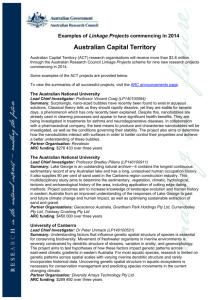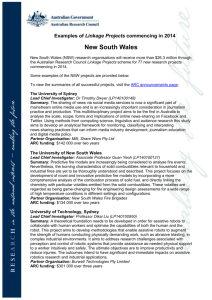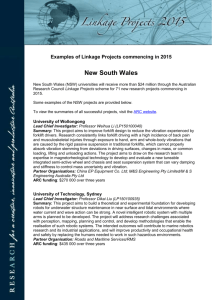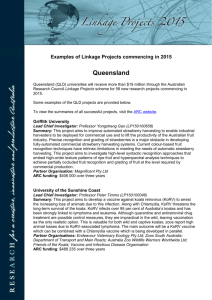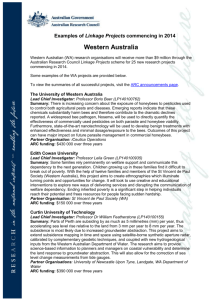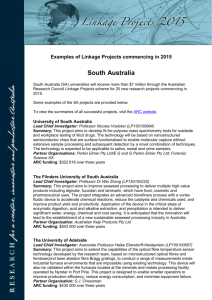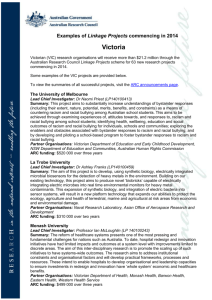Word Format - Australian Research Council
advertisement
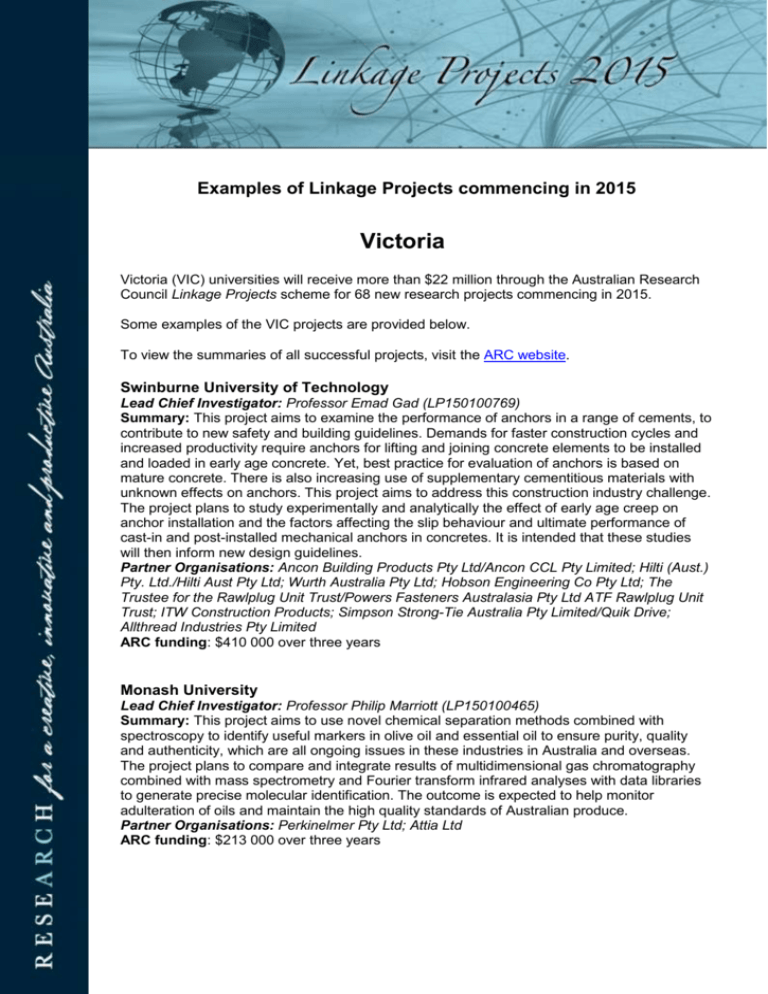
Examples of Linkage Projects commencing in 2015 Victoria Victoria (VIC) universities will receive more than $22 million through the Australian Research Council Linkage Projects scheme for 68 new research projects commencing in 2015. Some examples of the VIC projects are provided below. To view the summaries of all successful projects, visit the ARC website. Swinburne University of Technology Lead Chief Investigator: Professor Emad Gad (LP150100769) Summary: This project aims to examine the performance of anchors in a range of cements, to contribute to new safety and building guidelines. Demands for faster construction cycles and increased productivity require anchors for lifting and joining concrete elements to be installed and loaded in early age concrete. Yet, best practice for evaluation of anchors is based on mature concrete. There is also increasing use of supplementary cementitious materials with unknown effects on anchors. This project aims to address this construction industry challenge. The project plans to study experimentally and analytically the effect of early age creep on anchor installation and the factors affecting the slip behaviour and ultimate performance of cast-in and post-installed mechanical anchors in concretes. It is intended that these studies will then inform new design guidelines. Partner Organisations: Ancon Building Products Pty Ltd/Ancon CCL Pty Limited; Hilti (Aust.) Pty. Ltd./Hilti Aust Pty Ltd; Wurth Australia Pty Ltd; Hobson Engineering Co Pty Ltd; The Trustee for the Rawlplug Unit Trust/Powers Fasteners Australasia Pty Ltd ATF Rawlplug Unit Trust; ITW Construction Products; Simpson Strong-Tie Australia Pty Limited/Quik Drive; Allthread Industries Pty Limited ARC funding: $410 000 over three years Monash University Lead Chief Investigator: Professor Philip Marriott (LP150100465) Summary: This project aims to use novel chemical separation methods combined with spectroscopy to identify useful markers in olive oil and essential oil to ensure purity, quality and authenticity, which are all ongoing issues in these industries in Australia and overseas. The project plans to compare and integrate results of multidimensional gas chromatography combined with mass spectrometry and Fourier transform infrared analyses with data libraries to generate precise molecular identification. The outcome is expected to help monitor adulteration of oils and maintain the high quality standards of Australian produce. Partner Organisations: Perkinelmer Pty Ltd; Attia Ltd ARC funding: $213 000 over three years The University of Melbourne Lead Chief Investigator: Dr Margaret Simons (LP150100321) Summary: This project aims to explore the link between the internal operations of news media organisations, news media outputs and their impact on community attitudes to violence against women. Current literature indicates that the paucity and tone of news reporting of violence against women perpetuates harmful attitudes towards women. International and Australian research has consistently identified community attitudes as a key causal factor in violence against women. However, there is a lack of research into the impact of newsroom operations, including gender politics, on news media outputs, and the impact of those outputs on community attitudes. The proposed research and intervention project seek to address this shortfall. Partner Organisations: Victorian Health Promotion Foundation/VicHealth; Domestic Violence Resource Centre (Victoria); Victorian Equal Opportunity and Human Rights Commission ARC funding: $106 000 over two years La Trobe University Lead Chief Investigator: Associate Professor Adam Schembri (LP150101101) Summary: This project aims to improve our understanding of how to teach sign languages to adults as second and additional languages. Internationally, there is significant demand for sign language classes, but relatively little is known about the processes involved when hearing adults learn a sign language, or the similarities and differences to second language learning of spoken languages. This project aims to develop and test the efficacy of a range of innovative teaching materials and approaches, as well as create the first standardised Australian Sign Language (Auslan) test for adults. It aims to significantly improve the quality of Auslan teaching at the partner institution and provide a model of best practice internationally. Partner Organisations: Northern Melbourne Institute of Tafe (NMIT); Victorian Deaf Society/Vicdeaf ARC funding: $196 428 over two years Victoria University Lead Chief Investigator: Professor Yanchun Zhang (LP150100673) Summary: This project aims to improve access to electronic health data (EHD) while still ensuring patient privacy. EHD can provide important information for medical research and health-care resource allocations. However, data sharing in electronic health environments is challenging because of the privacy concerns of customers. Large-scale unauthorised access from internal staff has been reported in Medicare. This project aims to develop new privacypreserving algorithms on EHD database federations, which can provide efficient data access yet block inside attacks. It will significantly improve the data available for medical research, while reducing the cost of EHD system management and providing visualised decision supports to medical staff and the government health resource planners. Partner Organisation: Nexus Online Pty Ltd ARC funding: $295 467 over three years RMIT University Lead Chief Investigator: Professor Ralph Horne (LP150100089) Summary: The project plans to improve housing outcomes by evaluating housing design in the rapidly growing infill multi-residential sector, which often experiences design quality problems. Set across four global cities, the project aims to use a unique combination of design and social science methods to analyse good design and how this is produced and experienced. It is expected that this will deliver greater definition of and evidence for ‘good’ design as experienced through the real lives of Australian households. Outcomes should include robust design evaluation methods and transition strategies for cities, allowing city decision-makers to improve housing design for many people in Australian cities. Partner Organisations: Melbourne City Council (City of Melbourne)/City of Melbourne; Mirvac Limited/Mirvac Group; The Trustee for SJB Urban Unit Trust/SJB Urban Unit Trust; Department of Premier and Cabinet ARC funding: $466 328 over three years Deakin University Lead Chief Investigator: Professor Jeong Whan Yoon (LP150101027) Summary: This project aims to reduce waste in the production of aluminium cans. Over 200 billion aluminium beverage cans per year are produced worldwide (including 30 billion in Australia), but there is a problematic level of waste due to aluminium sheet forming failure. Current simulation of a multi-stage sheet forming process for rigid-packaging components results in a higher rejection rate due to the inaccuracy of conventional forming and fracture limit models. A novel development in this work is the design of a nonlinear strain path which is intended to maximise the forming limit of aluminium alloys and also estimate the safety margin up to the necking or fracture limit in the early die design stage. Partner Organisations: Alcoa Technical Centre; Korea Institute of Industrial Technology; Livermore Software Technology Corporation Organisation; ESI Korea Co Ltd ARC funding: $301 000 over three years The University of Melbourne Lead Chief Investigator: Professor Greg Qiao (LP150100315) Summary: In collaboration with Seagull Technologies, this project aims to engineer, study and mathematically model ultrasound-assisted biomacromolecule transport behaviour within polymeric gel systems, which may be useful in new drug delivery methods. The intended outcome is a novel set of polymeric gel systems, which can reversibly bind a wide variety of drugs (small molecules, nucleic acid based drugs, proteins), in which drug release is triggered by an electric potential and drug transport is controlled by means of sonophoresis. The main advantage of drug delivery via sonophoresis is elimination of risks associated with injections such as infection and damage to local tissue, and elimination of patient discomfort, pain and fear. Partner Organisation: Seagull Technology Pty Ltd/Seagull Technologies ARC funding: $ 314 954 over three years
